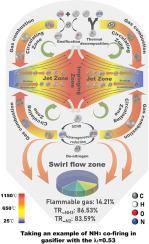利用氨/煤二元燃料气化-燃烧技术帮助脱硝和强化燃烧:注入位置和空气分布的影响
IF 9.4
1区 工程技术
Q1 ENERGY & FUELS
引用次数: 0
摘要
氨(NH3)与煤直接共燃是减少燃煤电厂碳排放的有效方法。然而,NH3 燃烧的局限性,如高点火能量要求和高氮氧化物排放,限制了其在燃煤机组中的大规模共燃。本研究采用自持式气化燃烧实验系统,在不同的 NH3 注入位置和配风方式下,对 NH3/煤二元燃料的脱硝性能和燃烧强化能力进行了评估。气化炉联合燃烧 20% NH3 的结果表明,通过调整一次空气比(λ1),其工作温度可灵活控制在 SNCR 的最佳反应温度窗口内。提高 λ1 有利于气化炉中 NH3 和煤的转化和脱硝;当 λ1 = 0.53 时,NH3 和 N2 的转化率分别达到 86.37 % 和 83.59 %,气化炉出口处未检测到氮氧化物。此外,增加 λ1 可促进气化炭孔隙结构的发展,从而提高反应活性。进入下燃式燃烧器(DFC)后,增加 λ1 可促进 NH3 和煤的燃尽,并有效控制氮氧化物的排放,在 λ1 = 0.53 的条件下,氮氧化物排放达到与纯煤类似的水平。在 DFC 中同时燃烧 20% 的 NH3 也表明,引入内二次风有利于炭的燃烧,但会增加 NH3 的滑移。外部二次空气促进了 NH3 的燃烧,但加剧了氮氧化物的排放,并抑制了气化炭的燃烧。均匀配风方法平衡了 NH3 和气化炭的燃烧,有效控制了氮氧化物的排放。当采用相同的配风方法时,在气化炉中共同燃烧 NH3 更有利于氮氧化物的控制,而在 DFC 中共同燃烧 NH3 则有利于煤的燃烧。这项研究为开发燃煤机组大规模 NH3 协同燃烧的强化燃烧和低氮氧化物排放技术提供了创新思路和参考。本文章由计算机程序翻译,如有差异,请以英文原文为准。

Assisting denitrification and strengthening combustion by using ammonia/coal binary fuel gasification-combustion: Effects of injecting position and air distribution
The direct co-firing of ammonia (NH3) with coal is an effective approach for reducing carbon emissions from coal-fired plants. However, the limitations of NH3 combustion, such as its high ignition energy requirement and high NOx emissions, restrict its large-scale co-combustion in coal-fired units. In this study, a self-sustaining gasification–combustion experimental system was employed, and its denitrification performance and combustion strengthening capability for NH3/coal binary fuel under different NH3 injection positions and air distribution methods were evaluated. The results of co-firing 20 % NH3 in the gasifier revealed that its operating temperature can be flexibly controlled within the optimal reaction temperature window of SNCR by adjusting the primary air ratio (λ1). Increasing λ1 was beneficial for NH3 and coal conversion and denitrification in the gasifier; at λ1 = 0.53, the conversion rate of NH3 and N2 reached 86.37 % and 83.59 %, respectively, with no NOx being detected at the gasifier outlet. Furthermore, increasing λ1 promoted the development of gasified char pore structure, thereby improving reactivity. After entering the down-fired combustor (DFC), increasing λ1 promoted NH3 and coal burnout and effectively controlled NOx emissions, reaching a level similar with that of pure coal under λ1 = 0.53. Co-firing 20 % NH3 in the DFC also demonstrated that the introduction of inner secondary air was conducive to char burnout, however, increased NH3 slip. The outer secondary air promoted NH3 combustion, however, exacerbated NOx emissions and inhibited gasified char combustion. The uniform air distribution method balanced the combustion of NH3 and gasified char, and effectively controlled NOx emissions. When the same air distribution method was used, co-firing NH3 in the gasifier was more favourable for NOx control, whereas co-firing NH3 in the DFC benefited coal burnout. This study provides innovative ideas and serves as a reference for developing enhanced combustion and low NOx emission technologies for large-scale NH3 co-firing in coal-fired units.
求助全文
通过发布文献求助,成功后即可免费获取论文全文。
去求助
来源期刊

Energy
工程技术-能源与燃料
CiteScore
15.30
自引率
14.40%
发文量
0
审稿时长
14.2 weeks
期刊介绍:
Energy is a multidisciplinary, international journal that publishes research and analysis in the field of energy engineering. Our aim is to become a leading peer-reviewed platform and a trusted source of information for energy-related topics.
The journal covers a range of areas including mechanical engineering, thermal sciences, and energy analysis. We are particularly interested in research on energy modelling, prediction, integrated energy systems, planning, and management.
Additionally, we welcome papers on energy conservation, efficiency, biomass and bioenergy, renewable energy, electricity supply and demand, energy storage, buildings, and economic and policy issues. These topics should align with our broader multidisciplinary focus.
 求助内容:
求助内容: 应助结果提醒方式:
应助结果提醒方式:


